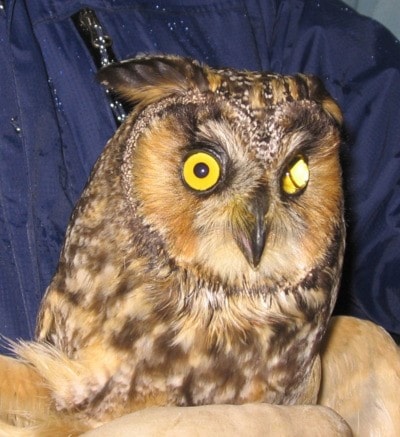One of the most elusive and secretive owls is the long-eared owl.
It is often thought to be the epitome of all owl species; it has the purest “hoot”, most cryptic plumage and the most hypnotic eyes. Long-eared owls rival the barn owl for the title of “master mouser” and also surpass them in their mysterious ways.
A medium-sized owl, long-eared owls inhabit open woodlands, forest edges, riparian strips along rivers for hunting but in addition require thickly wooded areas for nesting.
Although these owls are widely distributed across North America, Eurasia and northern Africa, they are rarely seen on Vancouver Island. These owls are found mainly in the interior of British Columbia, but there is a small population found in the Boundary Bay area of the Lower Mainland.
Because they are such an uncommon sight, there was great excitement when a presumably stray migrant was found in Victoria a few weeks ago. I was fortunate enough to see this owl during its brief stay at MARS. My first impressions were that it looked very much like the short-eared owl, but as I researched further, I found them to be significantly different.
Long-eared owls have very prominent ear tufts which sit more in the center of their head above golden yellow eyes that are surrounded by bright orangey brown facial disc feathers. The black beak is separated from the eyes by a cross of white feathers, and they also have a white chin patch.
These owls weigh between 259 and 282 grams with a wingspan between 96 and 100 centimetres, the female being larger than the male. The overall plumage is a cryptic combination of brown and buff with mottling and heavy barring across the chest. This allows them to virtually disappear when roosting against the trunk of a tree.
Buoyant and manoeuvreable, they are the ultimate silent fliers and are able to glide noiselessly even when flapping their wings; they are even able to navigate their way through dense brush. When searching for food, they resemble a moth, hovering and fluttering before pouncing on the prey.
Long-eared owls are strictly nocturnal and rival the barn owl in their ability to capture prey in total darkness. Hunting just after dusk until predawn, they fly low to the ground with their heads atilt listening for the patter of tiny rodents.
Their diet includes voles, moles, squirrels, bats and rabbits but they are also known to catch screech and saw whet owls, as well as juncos, blackbirds or other small birds which they catch on the wing. Vocalization for these owls is very diverse, and their sound can travel for at least one kilometre.
I listened to a recording of this owl and it was amazing, including a series of long “hoots” followed by an elongated throaty moan and finished off with a series of small “barks.”
Part of their mating ritual includes clapping their wings together under their body. One of the most bizarre displays happens when the female is threatened in the nest. Rather than dive bomb the intruder, she flies to the ground, where she proceeds to have an impressive “temper tantrum” rolling around shrieking, whining and hissing until the intruder leaves.
Long-eared owls rarely nest on the ground or in cavities; they reuse old stick nests built by ravens, hawks and herons that are hidden close to the tree trunk behind a screen of foliage. Eggs are produced over five or six days so hatching does not happen all at once. It takes the nestlings five weeks before they can fly and two months before they are fending for themselves.
Natural predators for these owls are great horned and barred owls, but raccoons prey upon their eggs. Humans also pose a threat to these and other owls especially at night through impacts with vehicles.
The long-eared owl that came to MARS was found by the roadside in Victoria. Obviously, it had been hit by a vehicle and sustained severe head, eye, and facial injuries. The owl was initially taken to Wild Ark, another rescue centre, and once it was making good progress, it was transferred to MARS for continued care.
When first admitted in Victoria, the owl was unable to open its mouth wide enough to eat and had to be force fed. The owl seemed to be progressing well but was still reluctant to feed on its own. Unfortunately, it died last week at MARS.
Initial tests indicate it may have succumbed to aspergillosis, a fungal infection that often attacks wildlife that already has a weakened immune system. Yet again, we are able to learn from these experiences and how to deal with unusual visitors about whom there is little documented information.
***
An update from my last article, the open house at MARS on April 3 has been postponed due to a “full house.” We continue to have many sick eagles and other raptors which require a quiet non-disruptive environment during their recovery.
We will announce the new date on our website and in the papers.
To report injured or abandoned wildlife, call 1-800-304-9968. For other calls, ring 250-337-2021 or check the web at www.wingtips.org.
Sandy Fairfield is the educational co-ordinator for the Mountainaire Avian Rescue Society (MARS). The MARS column appears every second Friday.



